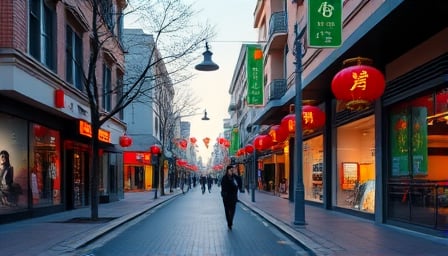CCOOP Group Co. Ltd. – A Retail Giant in the Midst of Market Volatility
The Shenzhen‑listed CCOOP Group Co. Ltd. (股票代码:—) remains a dominant player in China’s broadline retail space, operating flagship department stores in Xi’an and offering a wide range of products from apparel and jewelry to home furnishings. Despite its solid market presence, the company’s recent stock performance raises questions about investor confidence and the broader health of the retail sector.
Current Market Snapshot
- Last Closing Price (2025‑09‑04): 2.70 CNH
- 52‑Week Range: 1.57 – 4.38 CNH
- Market Capitalisation: 42.98 billion CNH
- Price‑to‑Earnings Ratio: –33.09
The negative P/E ratio reflects either a negative earnings figure or a market perception of impending profitability challenges. In an economy where retail is under pressure from e‑commerce giants and shifting consumer habits, a negative valuation metric is a red flag for any potential investor.
Retail Sector Performance on 5 September 2025
On 5 September, the Shanghai Composite Index rallied 1.24 % to 3,812.51 points, while the Shenzhen Component Index climbed 3.89 % to 12,590.56 points. The ChiNext Index surged 6.55 % to 2,958.18 points, signalling that high‑growth tech names were still attracting capital. However, the retail sector suffered a pronounced sell‑off:
- Key Retail Decliners: Guoguang Chain hit a daily stop‑loss, alongside Maoye Commercial, Sanjiang Shopping, Baida Group, Gongxiao Daji (the parent of CCOOP), and Youa Shares.
- Volume Impact: The overall market turnover dropped by 2.396 trillion CNH compared to the previous day, underscoring a liquidity pullback that disproportionately affected non‑growth sectors.
Given that CCOOP’s parent company, Gongxiao Daji, was cited among the retail losers, it is reasonable to infer that CCOOP’s shares experienced a similar downward trajectory. The market’s retreat from retail, combined with the negative P/E ratio, paints a bleak picture for the company’s near‑term valuation prospects.
Fund Flow Dynamics
The day’s net inflow of institutional capital reached 42.78 billion CNH across the Shanghai–Shenzhen market, yet the retail segment was a net outflow zone:
- Retail Outflow: 16.67 billion CNH drained from the “Commercial Trade and Retail” sector, the largest outflow among 31 primary industry groups.
- Contrasting Inflows: Energy equipment, electronics, and chemical sectors attracted the largest inflows, indicating a shift toward industries perceived as more resilient or growth‑oriented.
Thus, while the overall market enjoyed a healthy inflow, retail investors—particularly those holding shares in CCOOP—found themselves on the receiving end of capital flight.
Implications for CCOOP Group
- Liquidity Concerns: A declining share price in a capital‑tight retail environment may constrain the company’s ability to raise debt or equity, especially if its valuation remains below the prevailing market benchmark.
- Profitability Pressure: The negative P/E ratio suggests either current losses or expectations of future deterioration, both of which could erode shareholder value.
- Strategic Risk: CCOOP’s dependence on physical storefronts exposes it to the twin threats of e‑commerce competition and changing consumer preferences, particularly if it cannot diversify its revenue streams (e.g., into real‑estate or air‑freight services) effectively.
Outlook
The Shenzhen market’s current trajectory shows a clear preference for high‑growth, technology‑driven stocks, while traditional retail remains vulnerable. For CCOOP Group, survival will hinge on:
- Accelerating Digital Transformation: Integrating online platforms and omnichannel retail strategies to offset foot‑traffic declines.
- Cost Discipline: Tightening operational expenses to improve margins amid shrinking revenue.
- Capital Allocation: Prioritising investments that generate high returns, such as real‑estate developments or logistics services, to offset retail headwinds.
Until CCOOP demonstrates a credible turnaround plan, its stock is likely to stay under pressure, especially as institutional capital continues to flow away from traditional retail. Investors should view the current market environment as a warning sign rather than an opportunity.
